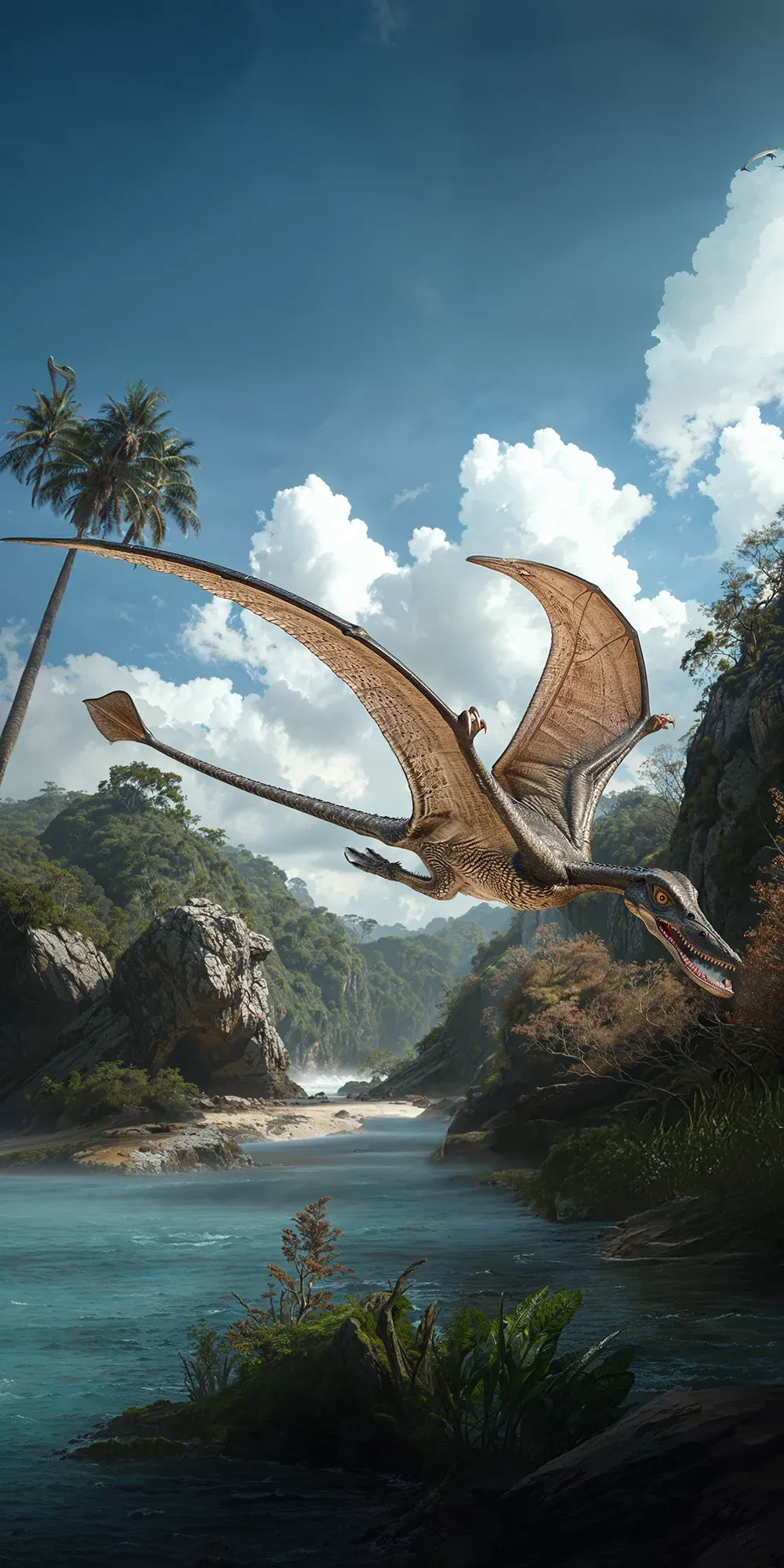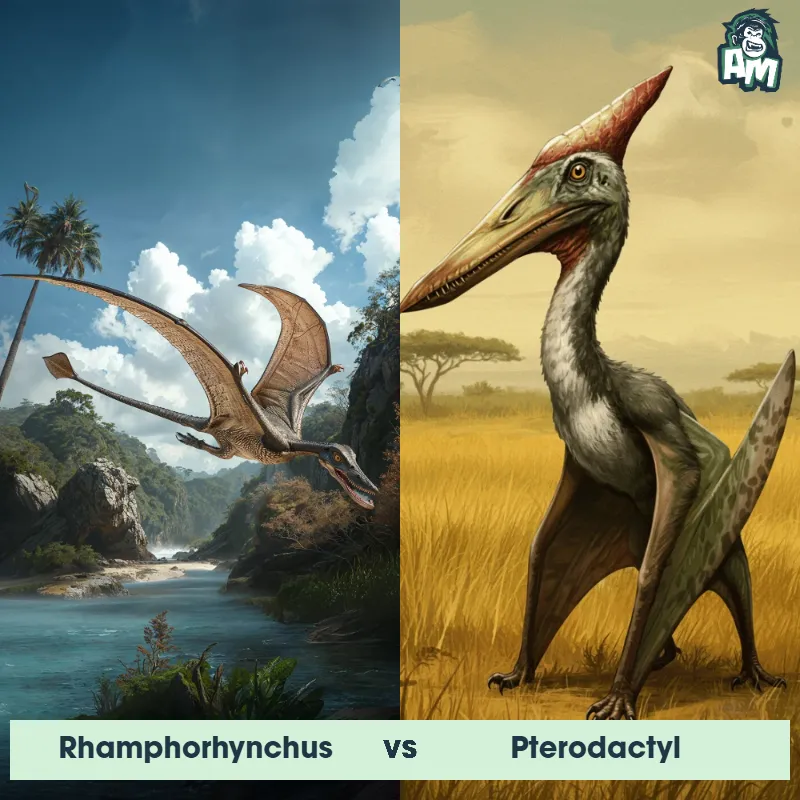The Rhamphorhynchus
Rhamphorhynchus, commonly known as the long-tailed pterosaur, was a type of flying reptile that lived during the Jurassic Period. It had a wingspan of about 1.8 meters and a long, pointed beak filled with sharp teeth. Its most distinctive feature was its long tail, which had a diamond-shaped flap at the end that may have helped with steering while flying. Rhamphorhynchus was a skilled flyer, using its wings to glide through the air in search of prey, which likely consisted of fish and other small animals.

| Rhamphorhynchus | |
|---|---|
| Size | 1.8 meters wingspan (5.9 feet), half length tail |
| Weight | Unknown |
| Speed | 25 mph (40 km/h) |
| Key Strength | Speed |
| Biggest Weakness | Size |
| Scientific Name | Rhamphorhynchus |
| Family | Rhamphorhynchidae |
| Habitat | Coastal areas |
| Geography | Europe |
| Diet | Fish |
| Lifespan | 15 years - 25 years |

The Rhamphorhynchus
Rhamphorhynchus, commonly known as the long-tailed pterosaur, was a type of flying reptile that lived during the Jurassic Period. It had a wingspan of about 1.8 meters and a long, pointed beak filled with sharp teeth. Its most distinctive feature was its long tail, which had a diamond-shaped flap at the end that may have helped with steering while flying. Rhamphorhynchus was a skilled flyer, using its wings to glide through the air in search of prey, which likely consisted of fish and other small animals.
Fun Fact: Rhamphorhynchus is one of the earliest known pterosaurs, appearing around 150 million years ago.
| Rhamphorhynchus | |
|---|---|
| Size | 1.8 meters wingspan (5.9 feet), half length tail |
| Weight | Unknown |
| Speed | 25 mph (40 km/h) |
| Key Strength | Speed |
| Biggest Weakness | Size |
| Scientific Name | Rhamphorhynchus |
| Family | Rhamphorhynchidae |
| Habitat | Coastal areas |
| Geography | Europe |
| Diet | Fish |
| Lifespan | 15 years - 25 years |
Rhamphorhynchus Matchups
We use AI to simulate matchups between the Rhamphorhynchus and other animals. Our simulation considers size, strength, and natural predatory behaviors to determine the most likely outcome.

Can't find the Matchup you want?
Create Your Own MatchupRhamphorhynchus: Diet, Predators, Aggression, and Defensive Behaviors
What did Rhamphorhynchus eat?
Rhamphorhynchus primarily fed on fish and other small marine animals. Their long, pointed teeth were well-suited for catching slippery prey in the water. These creatures were considered piscivores, meaning they had a diet mainly consisting of fish.
Did Rhamphorhynchus have any predators?
While Rhamphorhynchus were one of the top predators in their ecosystem during the Late Jurassic period, they may have been preyed upon by larger carnivorous dinosaurs, such as the Pterosaur species Ornithocheirus. Additionally, these flying reptiles may have also been at risk of being hunted by other aerial predators or scavengers.
Were Rhamphorhynchus aggressive?
Rhamphorhynchus were not known to be particularly aggressive creatures. They likely relied on their hunting skills and agility in flight to catch prey, rather than engaging in confrontations with other animals. These long-tailed pterosaurs were more focused on survival and finding food sources rather than seeking out conflicts.
Did Rhamphorhynchus fight?
Rhamphorhynchus may have engaged in territorial disputes or competition for mates, which could lead to clashes between individuals. However, their primary mode of interaction was likely display behaviors, rather than physical fights. These interactions could involve posturing, vocalizations, and aerial displays rather than direct combat.
How did Rhamphorhynchus defend themselves?
Rhamphorhynchus utilized their agility in flight as their primary defense mechanism. They were able to quickly take to the air to escape from predators or threats on the ground. Their long, pointed teeth could also be used for defense if necessary, delivering a sharp bite to deter attackers. Additionally, group behavior or flocking may have provided safety in numbers against potential threats.
What was Rhamphorhynchus's biggest weakness in a fight?
Despite their aerial prowess, Rhamphorhynchus's long tail was a potential weakness in combat situations. The elongated tail, which was used for stabilization during flight, could be a vulnerable target for predators or rivals. A well-timed attack aimed at the tail could disrupt their flight and put them at a disadvantage in a fight.
Fun Fact: Despite its relatively small size, Rhamphorhynchus was a successful predator, catching fish with its sharp teeth while flying over bodies of water.
Fun Fact: The name "Rhamphorhynchus" comes from the Greek words for "beak snout," referring to its distinctive long, pointed beak.











